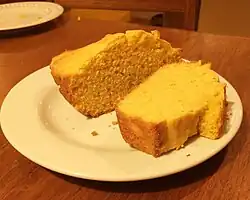Cornbread

Cornbread (pan de maiz in Spanish) is bread made primarily from cornmeal. For thousands of years, the native peoples of the Americas made meal from maize for use in baking batter bread, often with other ingredients such as chestnuts, sunflower seeds, berries, peppers, beans, or potatoes. Besides water, common ingredients used in making cornbread are salt, yeast, butter, sugar, wheat flour, buttermilk, eggs, baking soda, baking powder, bacon bits, or pork fat.
Quotes
- ... There had been very little in the house again that day to eat; some salty soup Ada had made by boiling several fat-back rinds in a pan of water, and corn bread, was all there was when they had sat down to eat.
- Erskine Caldwell, Tobacco Road. University of Georgia Press. 1995. p. 6. ISBN 082031661X. (1st edition 1932)
- Hariot and the other early settlers had learned the cornbread techniques of the natives, but it's difficult to say when the Europeans first created their own style of cornbread by mixing corn with wheat. In the 1630s, Captain John Smith clearly stated that the Virginian settlers had "plentie" of bread, made from wheat, corn, and rye. But were they mixing these grains together? ...
What all the early settlers in North America likely learned from the native populations was how to make corn "pone," which in the various native languages is oppone, apan, suppawn, etc. Captain Smith mentions pones as early as 1612. The indigenous ones were probably thin cakes baked in front of the fire or actually in the ashes of the fire, and, of course, they didn't originally have any wheat in them. But to Europeans these pones probably seemed a bit dense. They didn't have any leavening, after all, and they probably didn't have any shortening. All they contained, most likely, was cornmeal, water, and maybe salt. One Dutch visitor to Plymouth called the pones "good but heavy." That's putting it nicely.- Jeremy Jackson, The Cornbread Book: A Love Story with Recipes. New York: HarperCollins. 2003. pp. 8–9. ISBN 0060096799.
- The North thinks it knows how to make corn bread, but this is a gross superstition. Perhaps no bread in the world is quite as good as Southern corn bread, and perhaps no bread in the world is quite so bad as the Northern imitation of it.
- Mark Twain, Mark Twain's Own Autobiography: The Chapters from the North American Review. Wisconsin Studies in American Autobiography. University of Wisconsin Press. 1990. p. 113. ISBN 0299125408. (edited by Michael J. Kiskis)
External links
 Encyclopedic article on Cornbread on Wikipedia
Encyclopedic article on Cornbread on Wikipedia- (September 7, 2018)"Learn to cook a traditional Cherokee corn bread". Belle News-Democrat, YouTube.